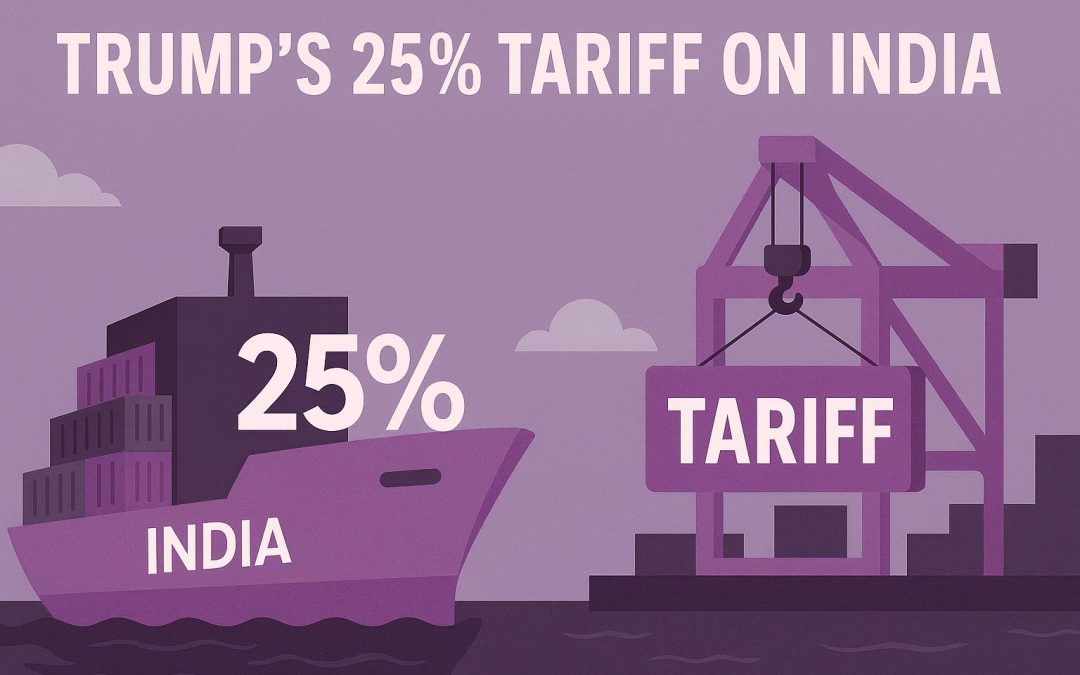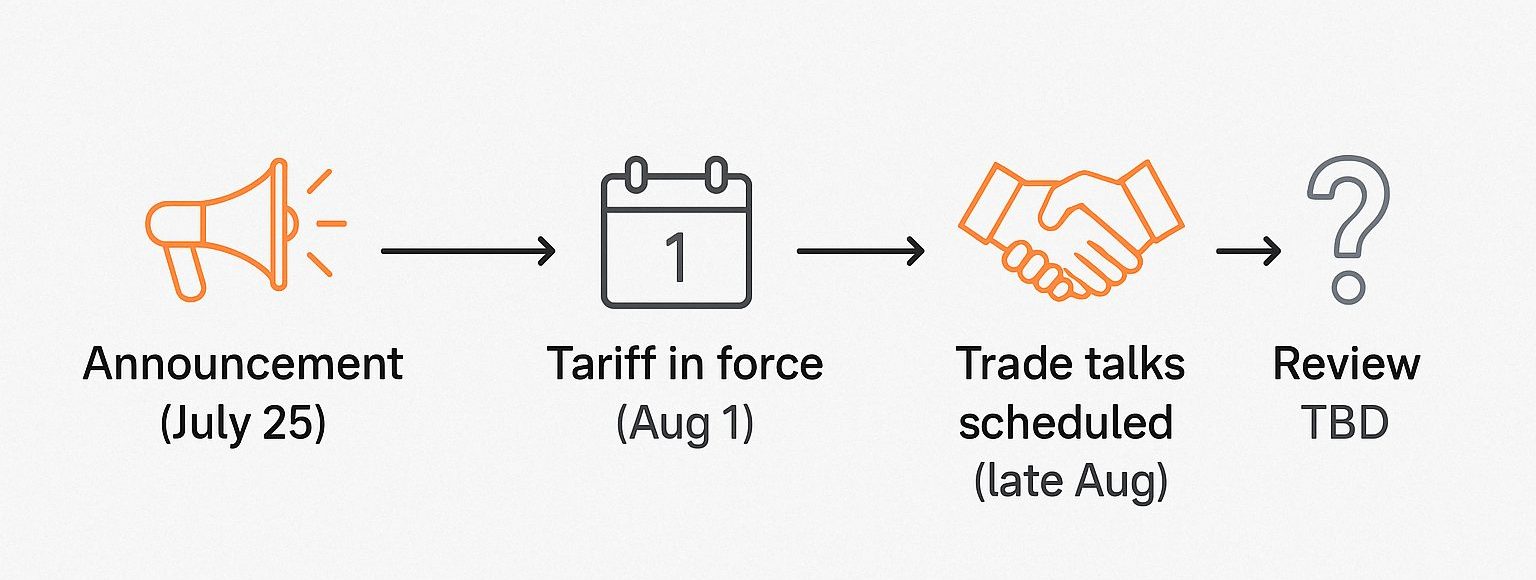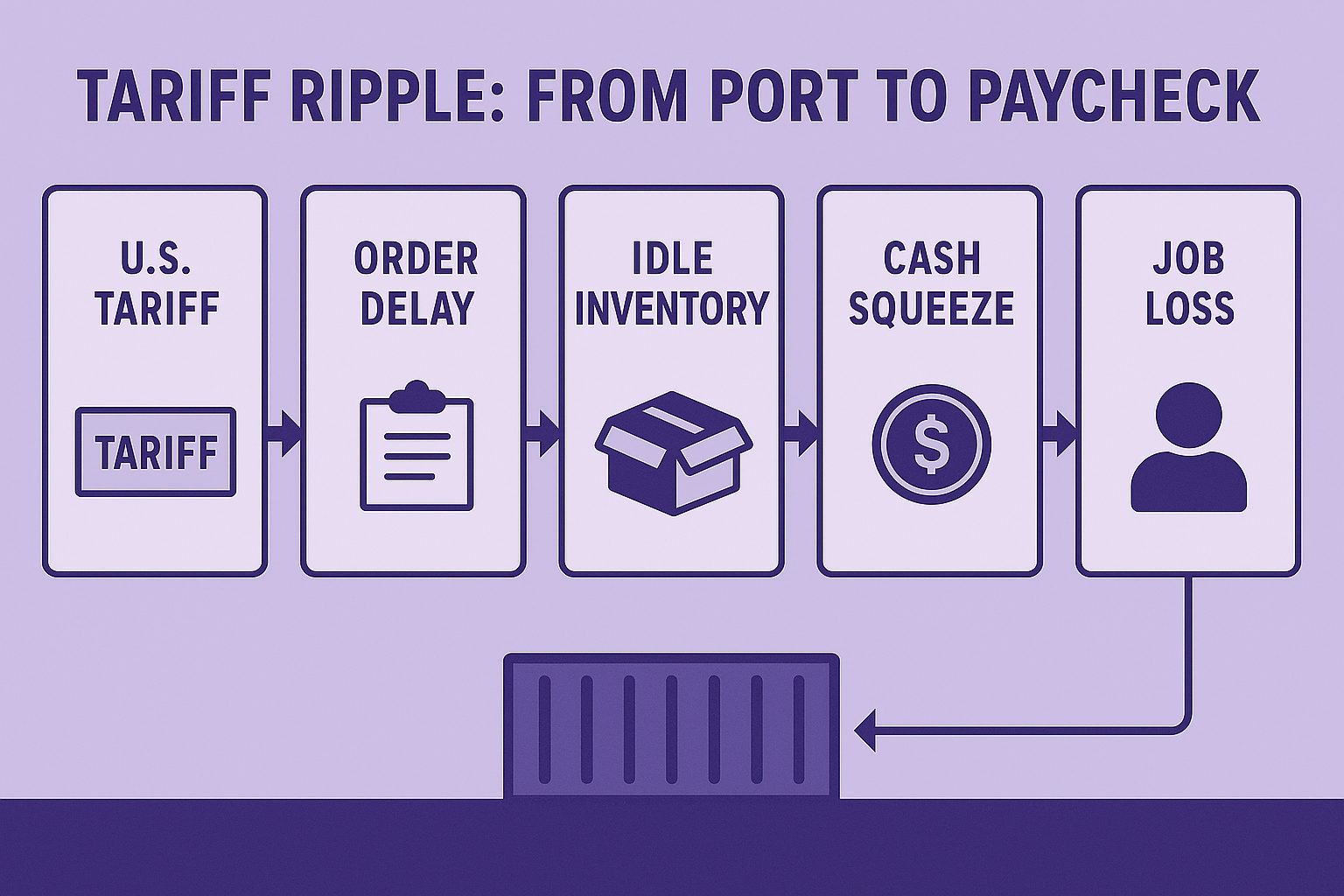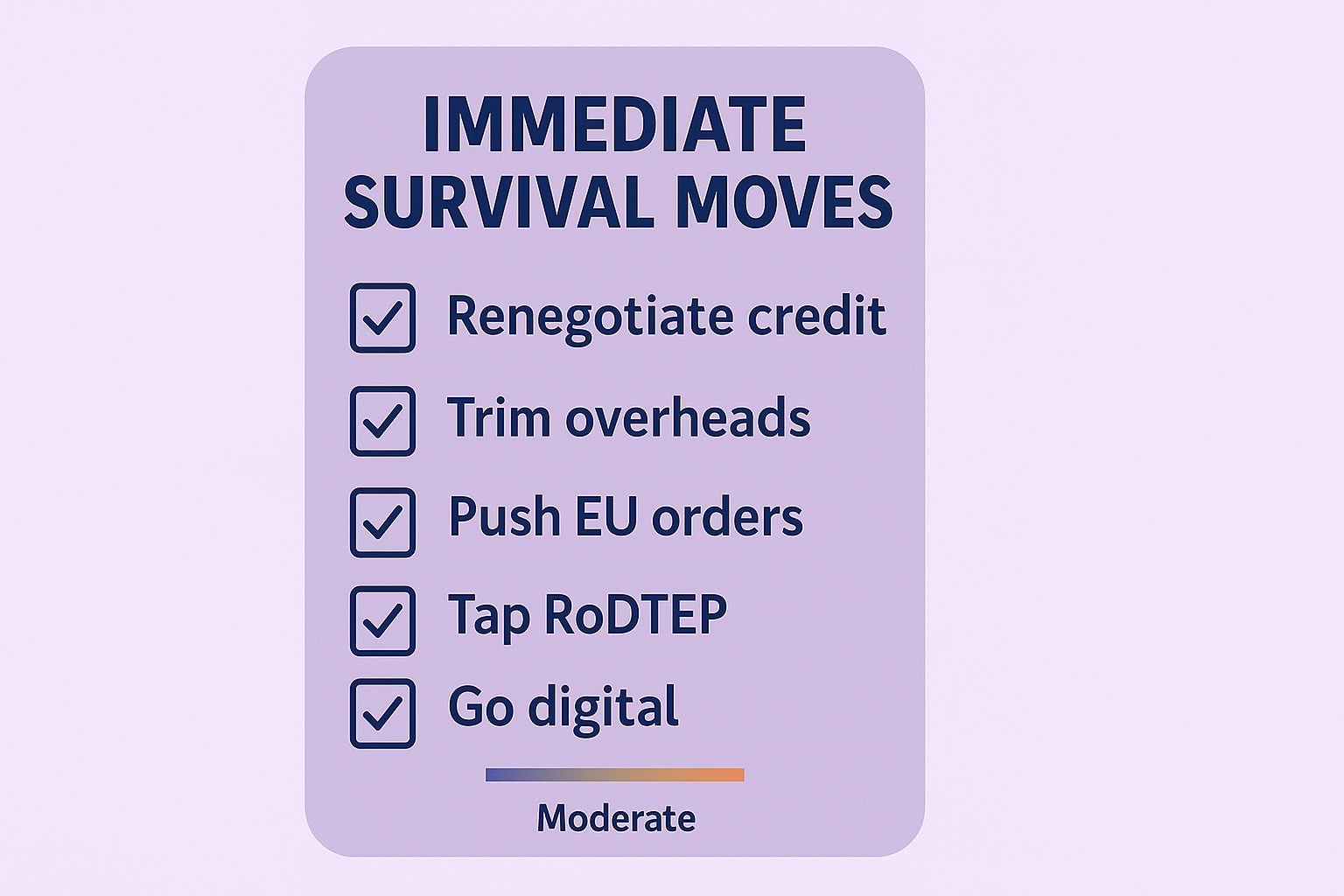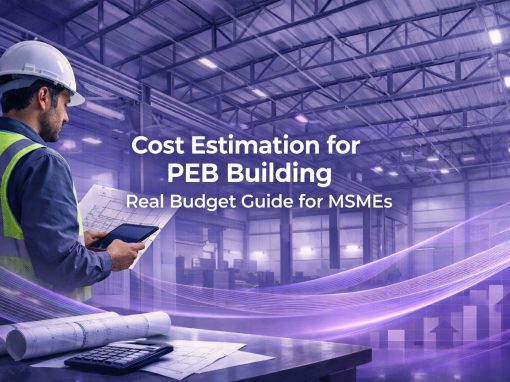Table of Contents
Trump’s 25% Tariff on India has jolted the country’s small-business landscape overnight. From 1 August 2025, every product shipped from India to the United States carries this sudden levy, announced without warning by the Trump administration. For the nation’s Micro, Small and Medium Enterprises—firms that supply everything from brake pads and pumps to cotton tees and carved décor—this isn’t a minor bump. They generate about a third of national output and nearly half of all exports; a quarter-markup can vaporise hard-won margins in a single billing cycle.
Orders are already being questioned, quotations re-opened, and production schedules re-drawn. Workers wonder if overtime will vanish, owners worry if bank limits will stretch, and competitors in lower-duty nations are circling for market share. The pages ahead unpack the fallout, Delhi’s counter-moves, and the survival strategies MSMEs must weigh in this newly tilted trade arena.
The New Tariff Policy Explained
Scope and mechanics
- Product coverage: All HS codes of Indian origin—everything from forged crankshafts to hand-loomed rugs.
- Point of levy: Collected at U.S. ports; importers must pay before goods leave customs custody.
- Duration: Open-ended. The proclamation ties removal to “material changes” in India-Russia trade behaviour, but sets no review date.
Immediate effect: Purchase orders signed weeks ago are suddenly underwater, logistics firms are re-quoting freight plus duty, and Indian exporters must decide whether to absorb the cost, renegotiate, or reroute goods elsewhere. For many MSMEs, none of those choices come cheap—or quick.
Key MSME Sectors Under Threat
Five export pillars—auto parts, engineered metal goods, generics, textile/leather products, and handcrafted items—bring in most MSME foreign revenue yet operate on margins thinner than a hacksaw blade. Trump’s 25% Tariff on India slaps a blanket duty across the board, pushing U.S. buyers toward duty-free rivals and forcing Indian firms to slash quotes, shelve production, or hunt new markets.
Auto Components
Gear housings, brackets, seals—the staples of India’s auto clusters now clear U.S. customs a quarter pricier. Global carmakers won’t negotiate; they’ll simply pivot to Mexico or Thailand. Cash dries up first, overtime vanishes next.
Engineering Goods
Pumps from Coimbatore, fasteners from Ludhiana, valves from Belgaum survive on precise cost math. With the tariff, American distributors can source similar castings from Turkey or re-shore to Ohio. Idle CNC lines still rack up bank EMIs.
Pharmaceuticals
FDA audits already squeeze margins. Add 25 % duty and India’s penny-per-pill edge over Canada or Mexico disappears. Smaller contract plants risk losing dossiers they spent years—and lakhs—securing.
Textiles & Leather
T-shirts, towels, leather belts sell on pennies. Bangladesh and Vietnam remain duty-free zones, so buyers will migrate. Mills depending on peak-season orders face stockpiles and shrinking credit limits.
Gems & Handicrafts
Impulse goods—silver cuffs, carved rosewood boxes—stop moving when tags jump. Retailers can swap in Thai or Indonesian craft overnight. Shelf space lost today could take seasons to win back.
Export and Import Fallout
Trade never waits for policy debates—containers already at sea simply make or break on the new math. Here’s how the shock reverberates both ways.
Outbound Shock: Sales Suddenly on Stilts
Over $87 billion in Indian goods used to glide into U.S. ports each year; the tariff slams a surcharge on every carton. Within days, purchase managers start firing off “re-quote” emails, and some cancel outright—especially for time-sensitive shipments like holiday apparel or aftermarket auto spares. Freight forwarders pass the duty through to importers; importers pass it back as price-cut demands. Unless exporters swallow the 25 percent hit—an impossible diet for most MSMEs—orders drift toward ASEAN, Mexico, or near-shore U.S. suppliers. Cash-flow gaps widen, inventory lingers, and production lines throttle down to half-shift.
Inbound Pinch: Costlier Inputs, Slower Cycles
India may run a surplus with the U.S., yet thousands of MSMEs still source precision tooling, medical-device parts, and semiconductor bits from American firms. If the tariff fight turns into a tit-for-tat, those inputs risk their own levy—or at least longer customs inspections. A four-week delay on a specialized IC can idle an electronics SME for a quarter. Even without retaliation, U.S. suppliers may raise prices to cover heightened compliance costs, nudging Indian manufacturers toward more expensive EU or Japanese alternatives. Lead times stretch, working capital locks up, and just-in-time schedules grow jittery.
Economic Strain on MSMEs
A tariff looks like a line on a customs invoice, but its shockwaves run straight through workshop doors and household kitchens. Three pressure points tell the story.
Cash Flow on a Knife-Edge
Picture a dyeing unit in Panipat: fabric leaves the gate today, the buyer’s payment lands roughly sixty days later, and that money keeps the boiler stoked. Take away the order and the whole rhythm collapses. Electricity bills don’t pause, nor do GST filings or interest meters at the bank. Unless emergency credit or higher export rebates arrive fast, owners will start pawning assets just to keep the lights on.
Jobs Hanging by a Thread
Small factories and workshops employ around 110 million Indians—enough people to fill every seat in a dozen Mumbai suburbs. A five-day slowdown trims overtime; a month-long stall triggers layoffs. When that happens, rental dues go unpaid, grocery shop sales dip, and bus conductors collect fewer fares. The tariff is no longer a trade statistic; it’s an empty lunchbox in a worker’s locker.
Fragile Trust in Supply Chains
Global buyers value certainty more than charm. Miss a ship-date once and they’ll forgive it; miss twice and the next tender goes to someone else. With inputs delayed or rerouted, Indian exporters now juggle last-minute airfreight and fresh penalty clauses. Repairing that reliability later—new audits, extra insurance, sweetened credit terms—may cost more than surviving the present crunch.
Government & Industry Response
Delhi can’t wish away a quarter-surcharge, but it can soften the landing. Four levers are already in motion—some visible, some still on the drawing board.
Diplomatic Dialogue
Commerce officials have opened back-channel talks with the U.S. Trade Representative, chasing product-level carve-outs for labour-heavy lines—think garments, auto spares, low-value jewelry. Progress will hinge on how strongly Washington links the duty to India-Russia ties.
Financial and Policy Support
The Finance Ministry is weighing a sharper RoDTEP (Remission of Duties and Taxes on Exported Products) refund and a temporary two-point interest subsidy for export loans. SIDBI and ECGC plan top-up insurance covers so banks can keep MSME credit lines open.
Diversification Push
Fast-track talks with the EU and UK aim to lock in lower tariffs before the festive shipping rush. Simultaneously, logistics planners are nudging exporters toward the INSTC and Chabahar routes to reach Central Asia without crossing sanction minefields.
Digital Enablement
Platforms like ONDC are being primed for cross-border listings: automated catalog translation, integrated freight quotes, and escrow payments. The pitch—smaller firms can tap buyers in Africa or the Gulf without flying to trade fairs—may prove vital if U.S. orders stall through winter.
The Road Ahead: Risk or Reboot?
Trump’s 25% Tariff on India may look like an iron gate, but every supply-chain map hides side streets. In the short run, survival means ruthless cost checks, faster invoices, and a sales push into Europe, Africa, and the Gulf where duties hold steady. Mid-term, firms must swap imports for local tooling, tap automation grants, and hitch onto ONDC or other digital marketplaces that beam catalogues beyond Uncle Sam’s reach. Long game? Use the fire to forge tougher metal: cluster-level R&D funds, buyer-backed green upgrades, and free-trade pacts that outlast election cycles. Tariffs rewrite rules; they don’t cancel ambition.
FAQs
Will the 25% tariff apply to Indian-origin goods re-exported via third countries?
Are Indian service exports (IT, consulting, design) affected by this tariff?
No. The 25% tariff is currently limited to physical goods shipped from India. IT services, remote design, SaaS platforms, and BPO exports remain tariff-free—though geopolitical tensions may impact sentiment.
Can Indian exporters claim relief under WTO or trade treaties?
What is RoDTEP and how can it help MSMEs counter tariff loss?
RoDTEP (Remission of Duties and Taxes on Exported Products) offers tax refunds on embedded domestic levies. It doesn’t offset U.S. duties directly, but helps Indian exporters lower backend costs and stay price-competitive.
Are any Indian sectors exempt from the tariff?
How might U.S. importers respond to the tariff hike?
They may reduce Indian orders, renegotiate contracts, seek alternatives in Vietnam, Mexico, or Bangladesh, or ask Indian suppliers to absorb part of the duty through price cuts.
Can MSMEs shift to EU or Middle East markets easily?
Will Indian banks revise MSME credit terms due to the tariff shock?
How will the tariff impact India’s overall trade balance with the U.S.?
It could narrow the surplus India holds with the U.S., but not immediately. Many long-term contracts will run their course. Over time, exports may decline unless India regains cost-competitiveness or strikes policy deals.
Are there digital platforms MSMEs can use to diversify exports?
A product manager with a writer's heart, Anirban leverages his 6 years of experience to empower MSMEs in the business and technology sectors. His time at Tata nexarc honed his skills in crafting informative content tailored to MSME needs. Whether wielding words for business or developing innovative products for both Tata Nexarc and MSMEs, his passion for clear communication and a deep understanding of their challenges shine through.
